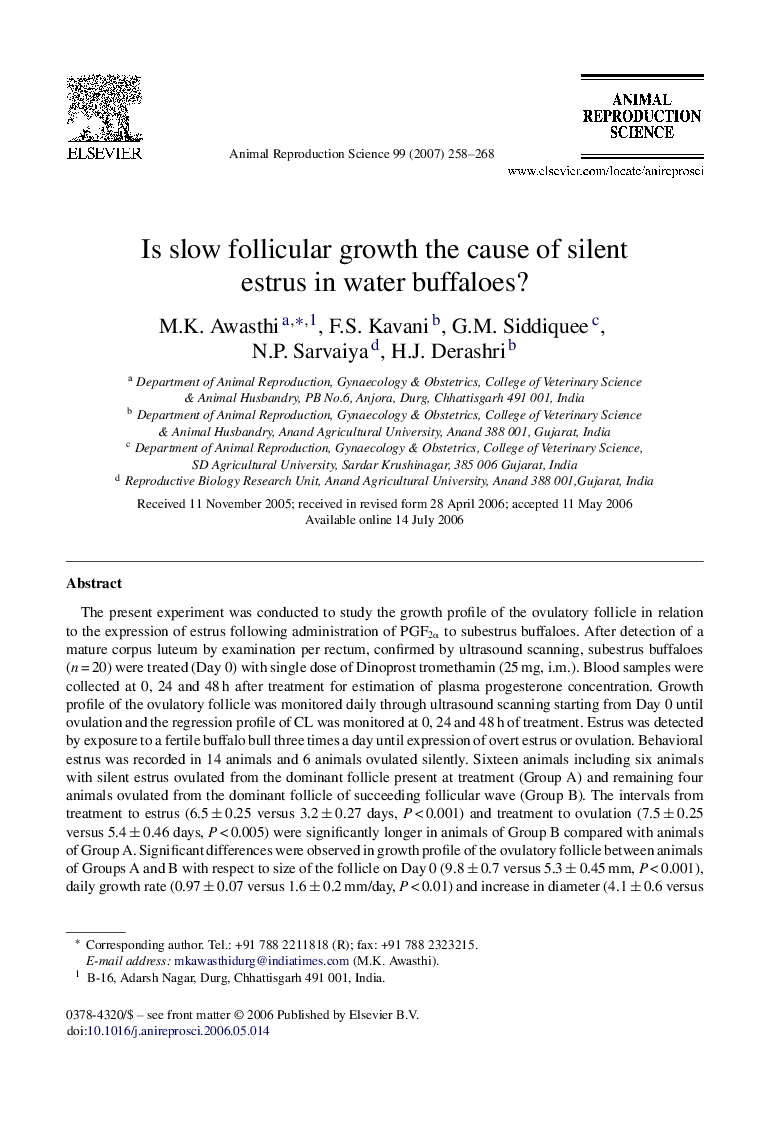| Article ID | Journal | Published Year | Pages | File Type |
|---|---|---|---|---|
| 2074820 | Animal Reproduction Science | 2007 | 11 Pages |
The present experiment was conducted to study the growth profile of the ovulatory follicle in relation to the expression of estrus following administration of PGF2α to subestrus buffaloes. After detection of a mature corpus luteum by examination per rectum, confirmed by ultrasound scanning, subestrus buffaloes (n = 20) were treated (Day 0) with single dose of Dinoprost tromethamin (25 mg, i.m.). Blood samples were collected at 0, 24 and 48 h after treatment for estimation of plasma progesterone concentration. Growth profile of the ovulatory follicle was monitored daily through ultrasound scanning starting from Day 0 until ovulation and the regression profile of CL was monitored at 0, 24 and 48 h of treatment. Estrus was detected by exposure to a fertile buffalo bull three times a day until expression of overt estrus or ovulation. Behavioral estrus was recorded in 14 animals and 6 animals ovulated silently. Sixteen animals including six animals with silent estrus ovulated from the dominant follicle present at treatment (Group A) and remaining four animals ovulated from the dominant follicle of succeeding follicular wave (Group B). The intervals from treatment to estrus (6.5 ± 0.25 versus 3.2 ± 0.27 days, P < 0.001) and treatment to ovulation (7.5 ± 0.25 versus 5.4 ± 0.46 days, P < 0.005) were significantly longer in animals of Group B compared with animals of Group A. Significant differences were observed in growth profile of the ovulatory follicle between animals of Groups A and B with respect to size of the follicle on Day 0 (9.8 ± 0.7 versus 5.3 ± 0.45 mm, P < 0.001), daily growth rate (0.97 ± 0.07 versus 1.6 ± 0.2 mm/day, P < 0.01) and increase in diameter (4.1 ± 0.6 versus 7.8 ± 0.7 mm, P < 0.01). The animals with silent estrus (subgroup A-2) had significantly smaller diameter of the ovulatory follicle on Day 0 (7.7 ± 0.4 versus 11.0 ± 0.7 mm, P < 0.005), its daily growth rate was significantly slower (0.7 ± 0.02 versus 1.1 ± 0.1 mm/day, P < 0.01) and they recorded significantly longer interval from treatment to ovulation (7.3 ± 0.56 versus 4.2 ± 0.27 days, P < 0.001) compared with the animals that showed overt estrus (subgroup A-1). The corpus luteum area (CL area) and plasma progesterone (P4) concentration declined continuously from 0 to 48 h after PGF2α treatment in the animals of both the Groups A and B. Non-significant differences were observed in mean CL area and plasma P4 concentration at 0, 24 and 48 h post-treatment between animals of Groups A and B and also between animals of subgroups A-1 and A-2. The small size and the slow growth rate of the ovulatory follicle were identified as the possible cause of silent estrus in subestrus buffaloes after PGF2α treatment.
